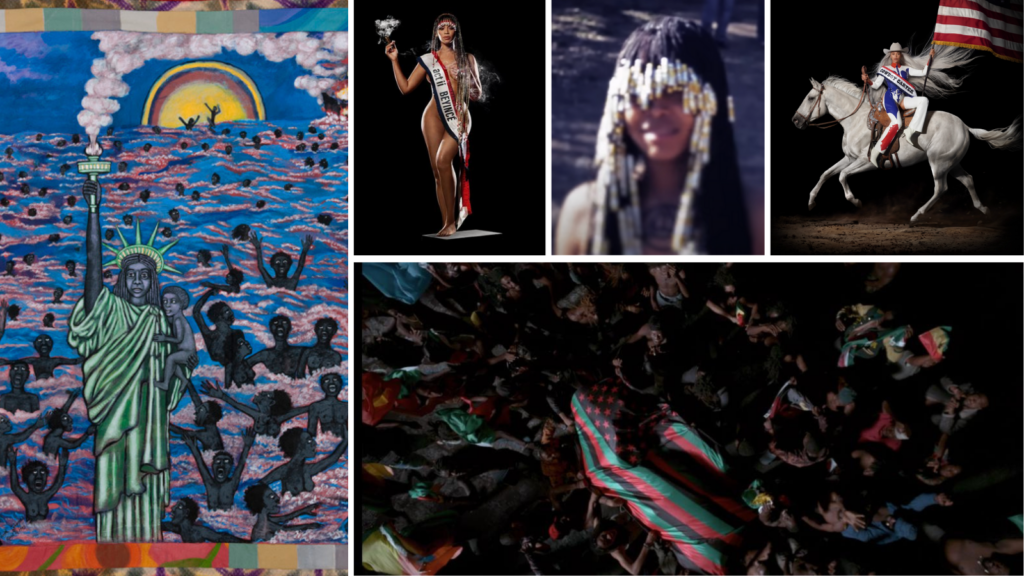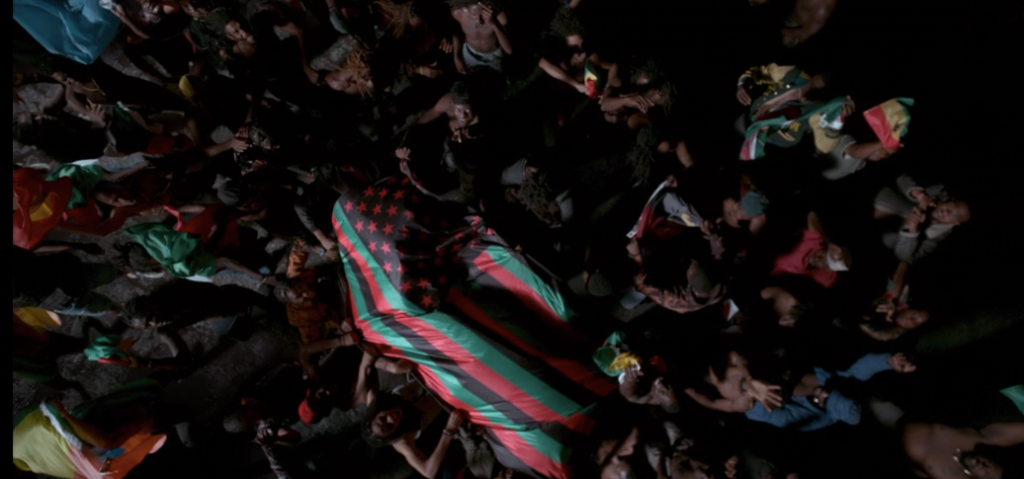Beyoncé as Lady Liberty seeks to rewrite history for racial inclusion and reclaim Black women’s rightful place in the pantheon of American symbols and heroes.

You may also like: “The symbolism of the American flag on the cover of Beyonce’s Cowboy Carter,” in which NPR’s A Martinez speaks to author and scholar Janell Hobson about the symbolism of the American flag on the cover of Beyonce’s new album.
We are one week away from the release of Beyoncé Knowles-Carter’s eighth solo album, billed as “Act II” of a three-part project that began two years ago with the release of Act I: Renaissance. The reveal of Cowboy Carter as the album title, along with the release of two country singles—the chart-topping “Texas Hold ‘Em” and “16 Carriages”—is a pivot from the house, disco and dance music-heavy, queer-friendly era of Renaissance, to the sounds of traditional country and all that comes with its associations: conservatism, patriotism, heteronormative whiteness, rodeo shows and down-South regionality.
Except this is Beyoncé we are talking about … who reminded us this week that the forthcoming project is “not a country album. This is a ‘Beyoncé’ album.” Of course, this only ramped up the speculation.
The conversation this week centered around the release of two album cover artworks:
The first serving as the official cover, depicting Beyoncé as a “Rodeo Queen” in keeping with the local traditions of rodeo shows in her hometown of Houston, Texas, featuring skilled horseback riding set against sartorial choices based in red-white-and-blue patriotism. This includes the pop star riding “side-saddle” in not-so-ladylike fashion, while donning a pageant sash (with the album title) and sporting impossibly white, bleached-blonde hair the same color as her white horse.
The second limited-album cover art offered a contrasting depiction of Beyoncé fully in the nude, with the exception of said sash (now labeled with her mother’s family name) strategically covering her lady parts as she poses with long beaded braids, with her right hand upraised in allusions to Lady Liberty while her other hand covers her left breast.
Other allusions here include Delacroix’s “Liberty Leading the People” or even Benoist’s “Madeleine (Portrait of a Negress),” the latter featured as penultimate artwork in Beyoncé and Jay-Z’s Louvre-based music video “Apes—t.”
As expected, social-media speculations exploded, and so did heated debates about how to politically interpret this new era of Cowboy Carter.
The question of politics mostly focused on the use of the U.S. flag in her official cover art and whether or not she sanctioned some kind of violent imperialism that this flag supposedly signifies—while riding atop a white horse that typically symbolizes “conquest” in the revolutionary paintings of leaders like George Washington and Napoleon—or if she is simply asserting her African American citizenship once historically denied until the 14th Amendment in the U.S. Constitution.
Such assertions are especially meaningful if Beyoncé pays homage to such contemporary Black rodeo trailblazers like Bill Pickett’s Rodeo Show or Black rodeo queen Ja’Dayia Kursh. Along with recent Black films—from The Bullitts’ The Harder They Fall, to Jordan Peele’s Nope, to even Melina Matsoukas’s Queen & Slim featuring dialogue about the resistant ways Black riders garnered respect from whites by eyeing them (literally looking down on them) from atop a horse—these allusions remind us of the rich history of Black folks participating in the settlement of the West.
These African American assertions are never simple, given how traditional American nationhood was often constructed around the very exclusion of its Black citizenry.
The actual inclusions of African Americans in U.S. history required our participation in the oppression of others—think of the “Buffalo soldiers” fighting Indigenous peoples. Granted, the opposite also occurred when Native American groups like the Cherokee enslaved African Americans in a quest for property and elevation of their status in white society. This did not prevent their removal in the Trail of Tears, however—and it is more than ironic that some of the first Black settlers in Oklahoma territory were once owned by Native Americans and helped to build what would become Black Wall Street in Tulsa, which was eventually destroyed by white supremacists in 1921 around the same time the Osage murders (recently dramatized in Martin Scorsese’s Killers of the Flower Moon) began in a bid to claim oil-rich land through the annihilation of Native peoples.
These histories of racial inclusion and exclusion obscure the place and space for Americans of color, especially African Americans, which makes Black historic reclamation complicated. This is especially true when African American civil rights struggles—from Black Power to Black Lives Matter—travel globally to inspire and influence various human rights battles beyond U.S. borders across the African continent, in the Black Diaspora, and elsewhere among various anti-colonial movements.
African Americans are often positioned to fight for their inclusion with the promise of American full citizenship, while their struggles against their exclusion often inspire global struggles against the very project of U.S. imperialism.
This is a history of contradictions—and it is very possible Beyoncé holds different meanings through her iconicity, thus inviting us to wrest with the contentions between our different interpretations.
Beyoncé previously featured the flag in her Black Diaspora-inspired visual album Black Is King, specifically one designed by artist David Hammons that showed the traditional U.S. flag in the Pan-African colors of red, green and black at the close of the track “Already.” Back then, some accused her of appropriating various African cultures, which suggests her lack of ownership of said cultures.

Are current flag wars similarly arguing that she should not “claim” the flag of her birth nation?
After all, her Act II depiction of the American flag is quite intentional, as is its feature in a visual collage with the Pan-African and LGBTQ+ rainbow flags just before her performance last year of “America Has a Problem” on her Renaissance World Tour, as fan accounts like BEY-Z-HIVE have highlighted.
We must consider especially her choice to crop the flag so that only the red stripes are depicted, thus conveying the possibilities of other flags of colonized and occupied spaces, like Liberia and Puerto Rico. This could even signify the “bleeding red stripes” of Black citizens and enslaved ancestors, as artist Faith Ringgold once visualized through her artwork “The Flag Is Bleeding.”
There is also the sincere possibility that Beyoncé’s image is tongue-in-cheek, signifying the campiness of her performance art, much like the disco horse she rides on for her Renaissance album cover.
At the center of her flag collage during her Renaissance tour, an image depicts Beyoncé in silhouette form as she holds a disco ball and studio light, again in the style of Lady Liberty. She irreverently implies that she—specifically her sexy, disco-dancing body—is the “problem” in “America Has a Problem,” the drug we cannot resist.
There are layers of subversion here, especially when she recreates the Lady Liberty allusion in her second album cover art for Act II.
The conversation around this second image was less heated and more centered around a shady post by neo-soul singer Erykah Badu, who implied that the image was inspired by her own work. Badu alludes to the controversy that followed her guerilla-style music video for her single “Window Seat” back in 2010, in which she stripped completely nude in public at the Dealey Plaza in her hometown of Dallas, Texas, the same site of the historic assassination of President John F. Kennedy, Jr.
Inspired by the indie-pop duo Matt and Kim, who did a similar stunt for their music video “Lessons Learned” in the height of winter in Times Square, Badu recreated a similar scenario that ends with her being shot by an invisible sniper—much like the assassinated president—in the same spot of the “grassy knoll,” while she provides commentary on “character assassination” based on “group think” (the culprit in her video).
There may be some truth to this, as the white band that inspired her were able to rely on their white privilege to “sweet-talk” their way out of an arrest by cops (albeit in a much more liberated city like New York) while Badu was charged with public disorder and forced to pay a fine and serve six months of probation for her nudity stunt.
The closing image of the video depicts Badu in similar beaded bangs while her long braids strategically cover parts of her nude body. It’s a fleeting image and one that many may have forgotten (and hence, why some of Beyoncé’s fans have been quick to dismiss Badu’s implied claims), but it was the ghost of an image of an “evolved” Black woman in her full fleshy and natural body able to overcome wider public assault.
Badu is not the only one seeing ghosts—and I would like to suggest other ghosts haunt this second image. I am especially recalling the possibly forgotten and emancipated Black women who once served as inspiration for French sculptor Frédéric Auguste-Bartholdi, whose gift of the Statue of Liberty commemorated the nation’s abolition of slavery, not an ode to immigration, which is what Lady Liberty has become as she welcomes new waves of immigrants (preferably from Europe) to America.
Interestingly, the sash Beyoncé wears that bears her maternal family name also recalls a similar history of immigrants arriving at Ellis Island, where they received new anglicized names. However, in the history of slavery and Jim Crow, her family name invites a different reading, in which African Americans might be subject to misspellings and incorrect labels for the official record. This is something that her mother Tina Knowles has shared—and it sounds quite similar to the story of Freedmen’s Bureau officials recording erroneous names for freed African Americans, as narrated in Toni Morrison’s Song of Solomon.
The name Beyoncé seems to be the result of misspelling on birth records in the South, where officials either disrespected its Black citizens or deliberately changed names to erase kinship ties with white families (something that may have occurred within Beyoncé’s Creole family).
Ghosts definitely abound here!
Beyoncé has said her forthcoming album is based on a “deeper dive” into the history of country music, which she felt compelled to research when she had felt “unwelcome” at an event. Most of us have guessed the event she is referring to is her appearance with the then-Dixie Chicks (now The Chicks) at the Country Music Awards show back in 2016. I had written in a review that this performance “remind[s] the show’s audience of [the South’s] diverse womanhood”—which may have led to the audience’s discomfort and racist complaints about the pop star appearing on the CMA stage.
The very Creolization of Beyoncé’s brown skin beauty disrupts the white evangelical purity myths of a conservative South reliant on racially and sexually pure white womanhood and subservient Black womanhood—neither image that the pop star embodies. As Sara Moslener, host of the Pure White podcast, suggests:
“If you go back to the 19th century and look at personifications of the United States, they’re white women. You have Lady Temperance and Lady Liberty. … This was part of a Victorian gender ideology that even white women would come to use in their own political work, asserting that white womanhood is the high-mark of civilization. This is the origin of the myths of innocence … because of course, none of that would work if [white] women weren’t presumed to be sexually pure.”
Depicting oneself as a (Black) Lady Liberty is a choice, and a powerful one that seeks to not only rewrite history for racial inclusion but to reclaim our rightful place in the pantheon of American symbols and heroes, while also resisting expectations for purity (racial and sexual).
Even here, Beyoncé remains satirical, as the smoke arising from the blunt in her right hand serves as that “beacon of light,” much like the smoke that arises from the flame of the torch that Black Lady Liberty holds in Faith Ringgold’s “We Came to America” artwork, which does the double-entendre work of burning a slave ship while providing clouds of a murky history waiting to clear.
This is a moment when real Black Lady Liberties are finally being recognized at the national level—like Harriet Tubman, who is featured in new commemorative Liberty coins this year (and who may also have inspired the first Black Lady Liberty on the 2017 coin) and who is also featured, along with Harriet Jacobs, author of Incidents in the Life of a Slave Girl, among 10 heroes of the Underground Railroad in a new collection of postage stamps. Acts of reclamation, like Beyoncé’s, are now positioned either to move us toward anti-racist feminist freedoms or fall back on old systems of white supremacy and patriarchy.
Black women as liberators have a long history of leading the way and have created spaces of resistance through their very embodiment. Fortunately, artists like Beyoncé are framing these conversations in the realm of popular culture. I anticipate her new album will do the same.
Up next:
U.S. democracy is at a dangerous inflection point—from the demise of abortion rights, to a lack of pay equity and parental leave, to skyrocketing maternal mortality, and attacks on trans health. Left unchecked, these crises will lead to wider gaps in political participation and representation. For 50 years, Ms. has been forging feminist journalism—reporting, rebelling and truth-telling from the front-lines, championing the Equal Rights Amendment, and centering the stories of those most impacted. With all that’s at stake for equality, we are redoubling our commitment for the next 50 years. In turn, we need your help, Support Ms. today with a donation—any amount that is meaningful to you. For as little as $5 each month, you’ll receive the print magazine along with our e-newsletters, action alerts, and invitations to Ms. Studios events and podcasts. We are grateful for your loyalty and ferocity.





